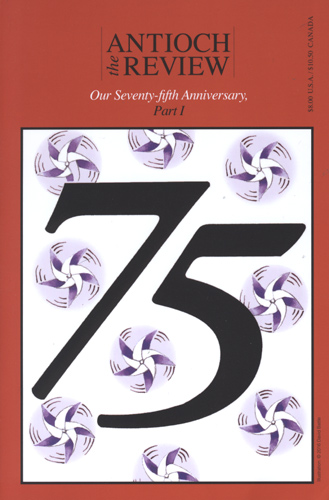The Antioch Review – Summer 2016
Let’s go back seventy-five years and meet ourselves again—because, as The Antioch Review has proven in its special anniversary edition, we did not hold the mirror closely enough back then, and we did not hear the message presented so clearly in the writings of people like Ralph Ellison, who laid before us in no uncertain terms our racial disparities and injustices, and in the poetry of that age. As Sidney Alexander explains in the poem “Prologue to Bolivar,” originally published in the autumn of 1944, we must “Roll back the dusty scroll, for no man lives / without his past: no man moves alone: / No man skates on time as if it were a film, but sees below him when the waters clear / the endless processionals of the dead.”
Let’s go back seventy-five years and meet ourselves again—because, as The Antioch Review has proven in its special anniversary edition, we did not hold the mirror closely enough back then, and we did not hear the message presented so clearly in the writings of people like Ralph Ellison, who laid before us in no uncertain terms our racial disparities and injustices, and in the poetry of that age. As Sidney Alexander explains in the poem “Prologue to Bolivar,” originally published in the autumn of 1944, we must “Roll back the dusty scroll, for no man lives / without his past: no man moves alone: / No man skates on time as if it were a film, but sees below him when the waters clear / the endless processionals of the dead.”
In the introduction to the current edition, Robert S. Fogarty traces the history of the Antioch from its earlier focus on social science and philosophy to its later turn to short fiction, poetry, and criticism as it embraced the concept that all literature is not to be measured against a few literary masters; it must arise from the ranks of the community, from “the impulse of literary creation” in every new generation. A journal such as Antioch serves as a “seedbed” for this new writing.
The cover of this edition is designed by longtime art director and illustrator at Antioch, David Battle. Battle’s choice of the old-fashioned toy is the kind of simple illustration he often works with to point to a larger cultural context—in this case, perhaps, his design may point to evolving sensibilities or to cyclical behaviors. I’ve read that the pinwheel is a symbol of turning one’s luck around; maybe we need a good, old fashioned wind to turn the wheel in our minds.
My friends, we have made some progress here and there, but reading “The Black Man’s Burden,” published in 1943, I find much that is familiar to this day—for example, “discriminatory practices in our public social institutions, and the arbitrary infringement of the Negro’s fundamental rights.” That year, J. Saunders Redding observes in this essay, there had been nine lynchings by mid-October. The rope has turned into a bullet in 2016, but young black men go on dying as surely as they did decades ago. Also, as in 1943 and 44, we go on engaging in terrible wars and trying to figure out what Lewis Corey called “Problems of the Peace,” among them the use of our national resources:
Shall the resources of American industry be used to promote cooperation among the world’s nation; or shall they be used, under pressure of monopoly imperialism, to fight for economic domination of the world and thus dynamite security and peace?
We do not know now much better than we did then, the answers to these questions. We resemble a nation mentioned by Jessie Treichler’s character Cora in the novel excerpt from “Homecoming,” “a country of crazy people” who buy our water in endless plastic bottles and pay more than one kind of price for it. We must become intellectuals again because, as the editor for the spring 1941 of Antioch explained, “the social role of the intellectual in our time is to employ ideas to further democracy in the fullest sense.” We have lost some of our intellectual footing. We cannot afford, as the editor further observes, to be “indifferent to the social struggle or to the blackout of learning, literature, and the arts which accompanies defeat in that struggle.”
We must overcome the “Self-Fulfilling Prophecy” as described by Robert K. Merton in 1948 and still so relevant: the habit of believing that a negative outcome is inevitable, and as a result making it happen. Merton’s essay is one of the more challenging in the journal with its elevated vocabulary and layered philosophies, but it is worth working through the challenges. Ultimately, he argues that there are “ample indications that a deliberate and planned halt can be put to the workings of the self-fulfilling prophecy and the vicious circle in society” if people are determined to change their expectations, stop translating their fears into reality and reject what he calls “social fatalism.”
I recommend as the last reading, James T. Farrell’s “Some Observations on Naturalism, So Called, in Fiction,” noting with enthusiasm his reminder that we need a variety of literature and “an increase in feeling and a desire for more freedom, more frankness, more understanding in the world.”
[review.antiochcollege.edu/about-antioch-review]





